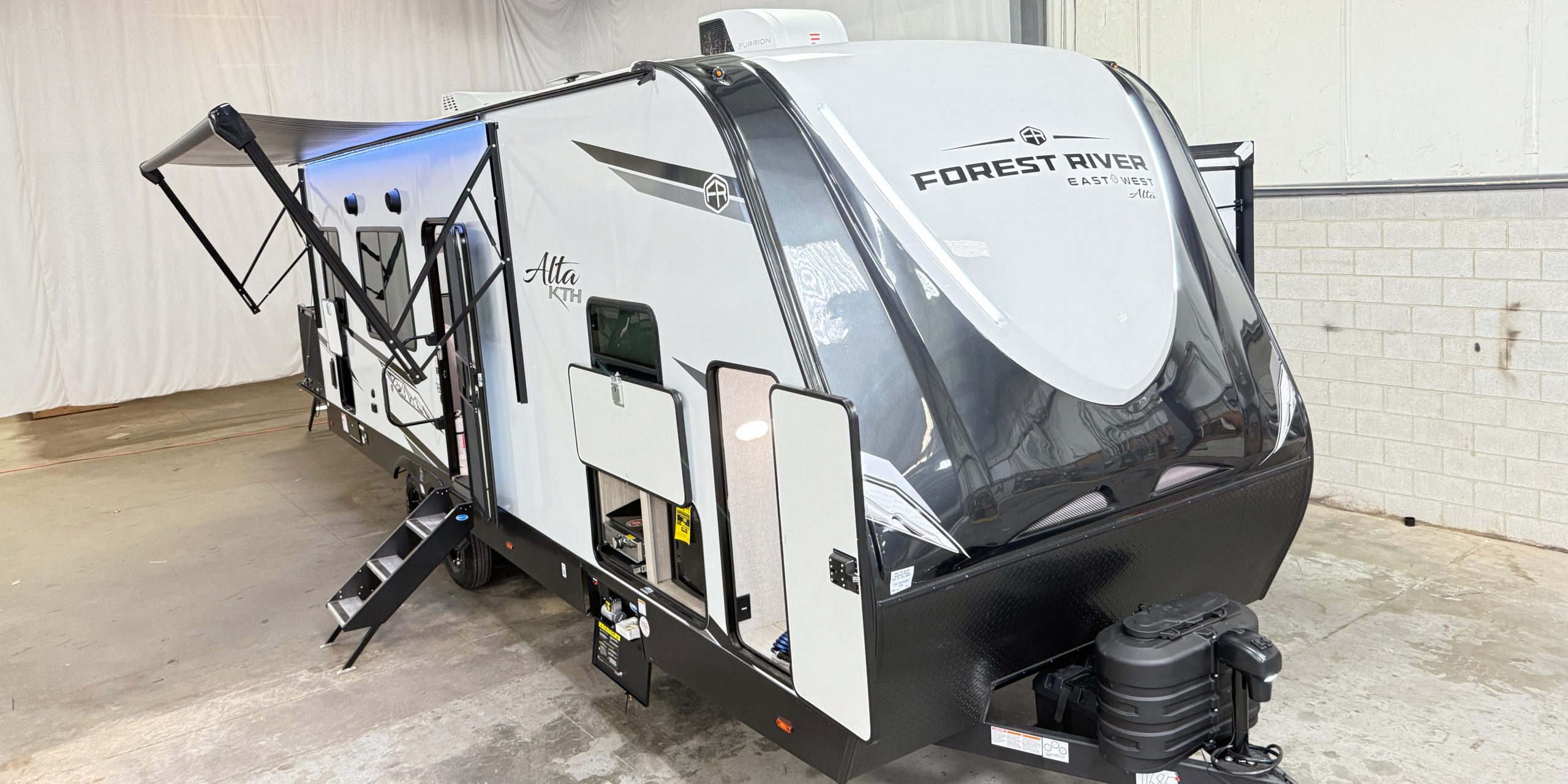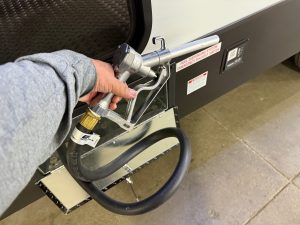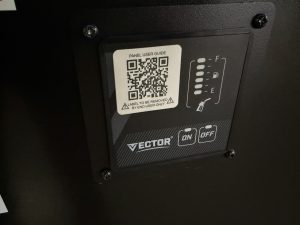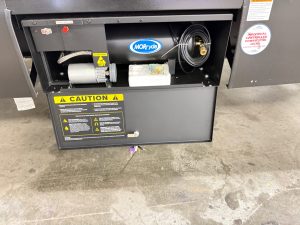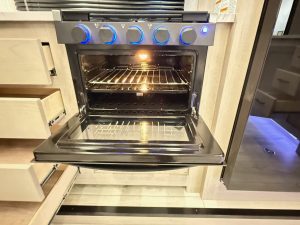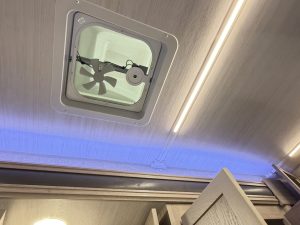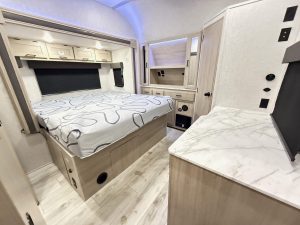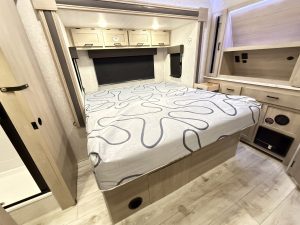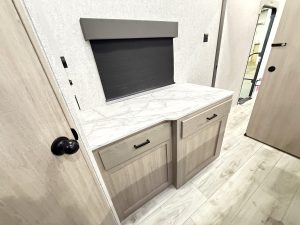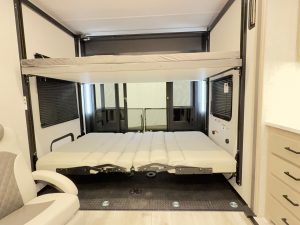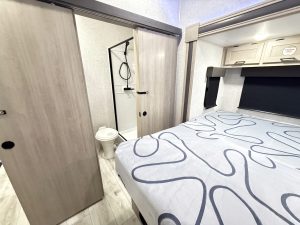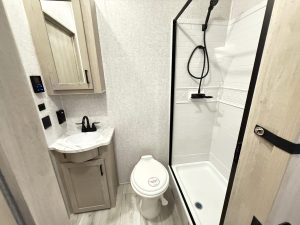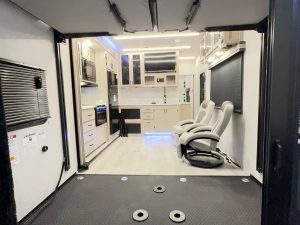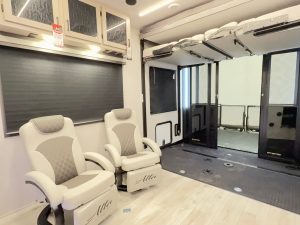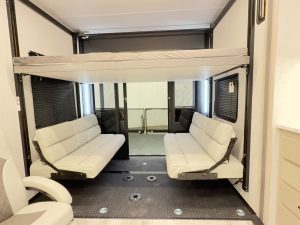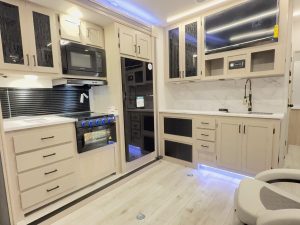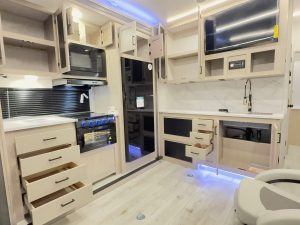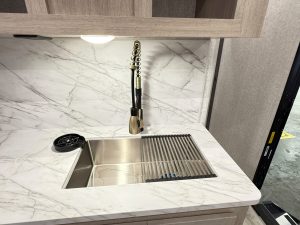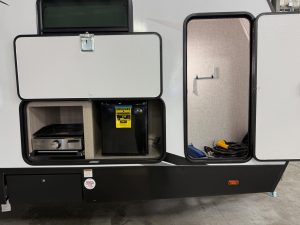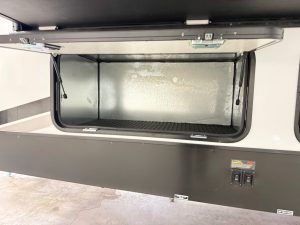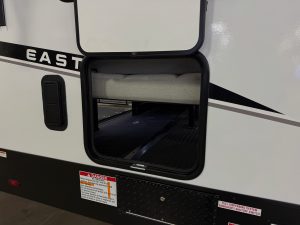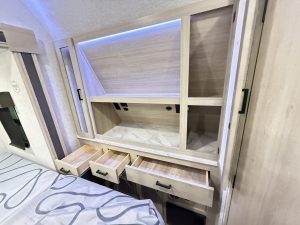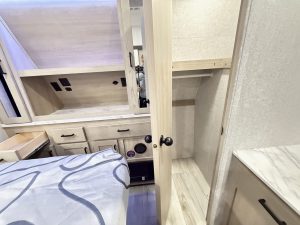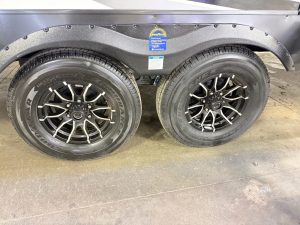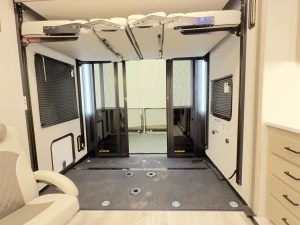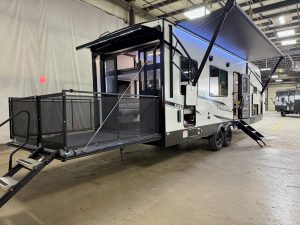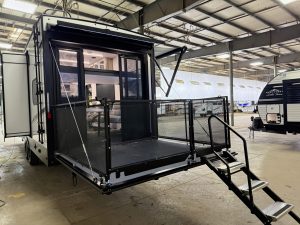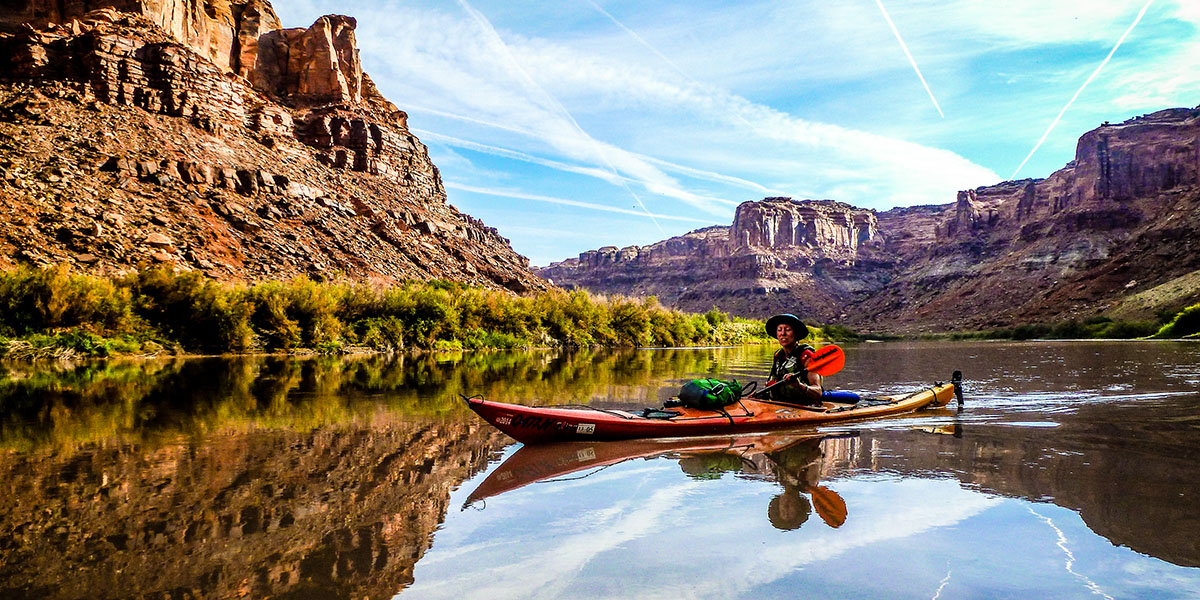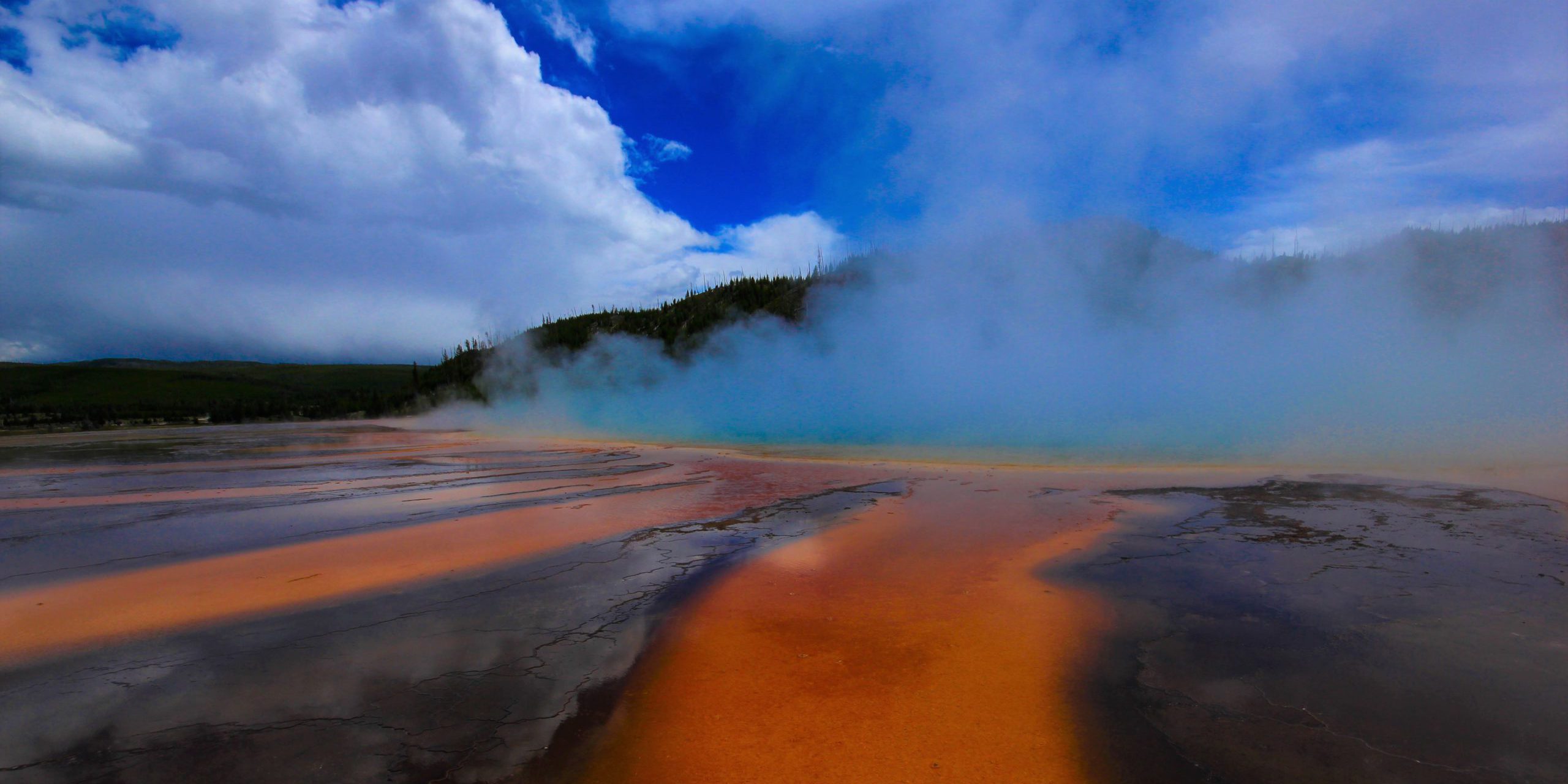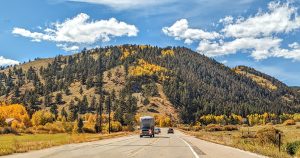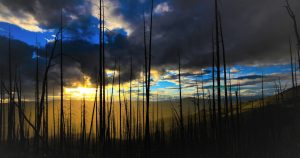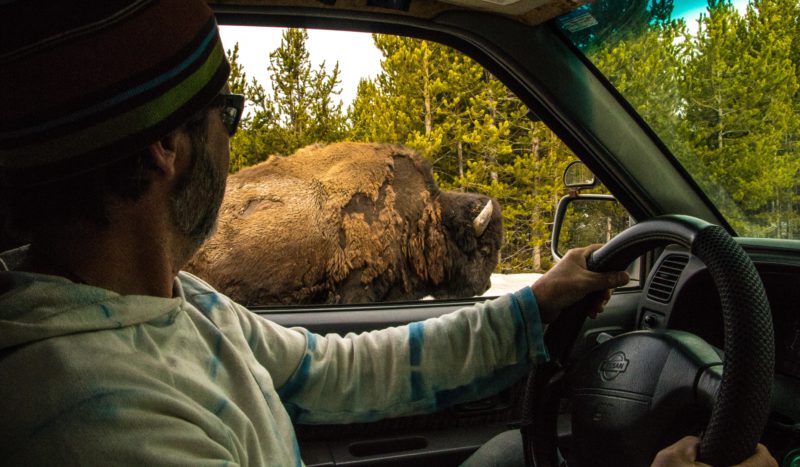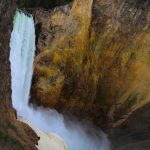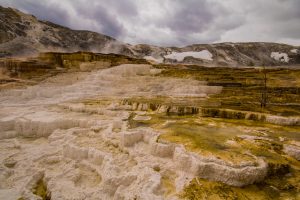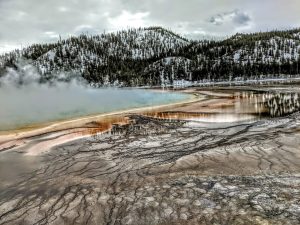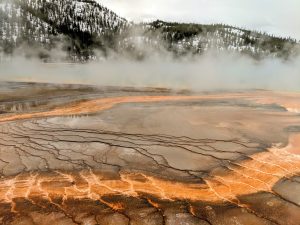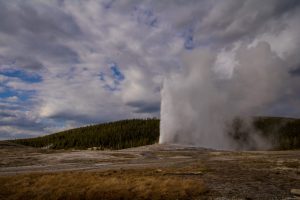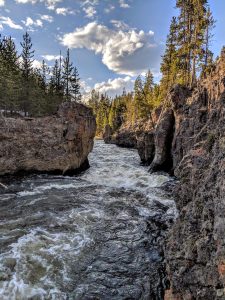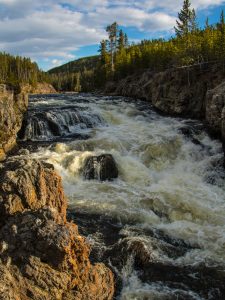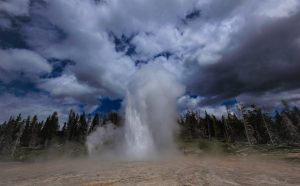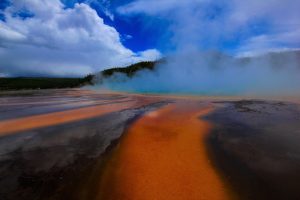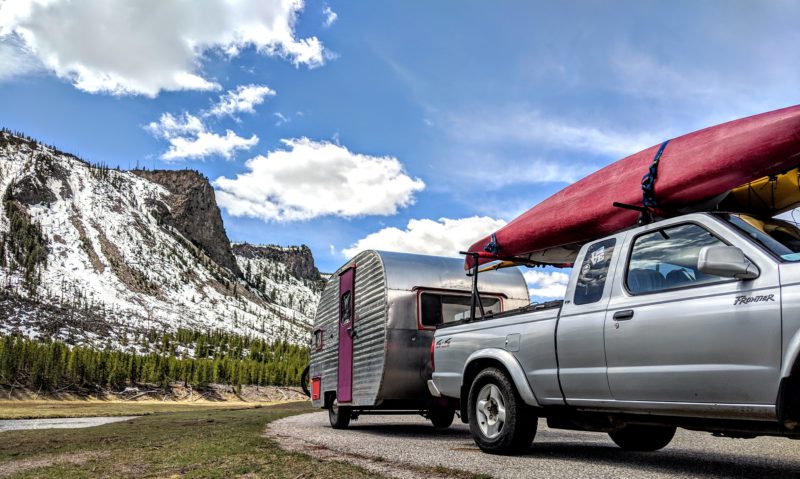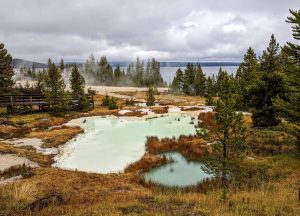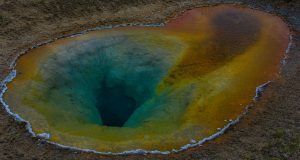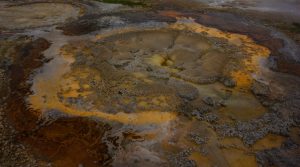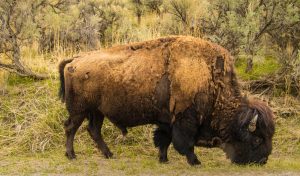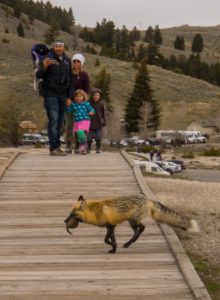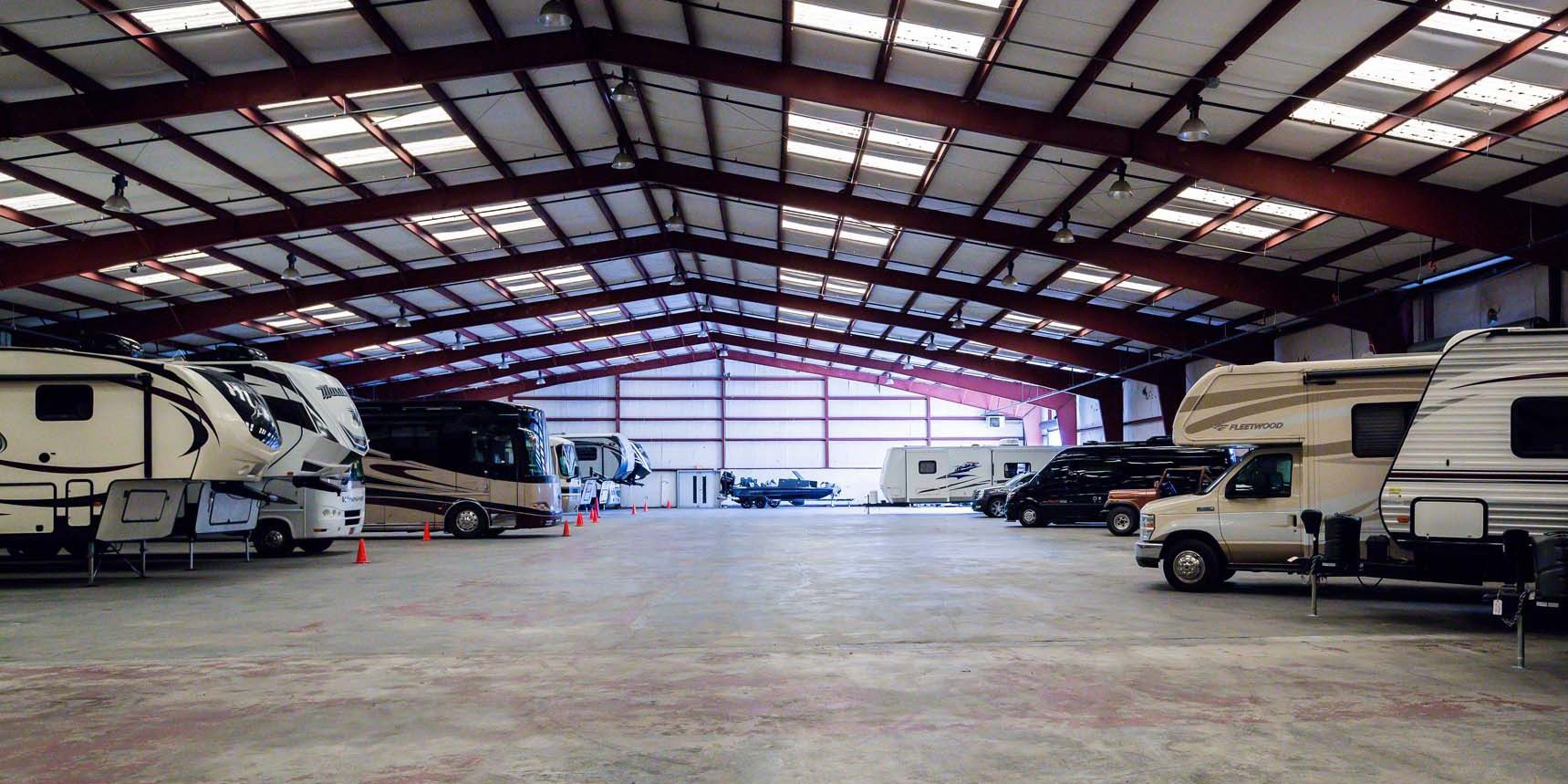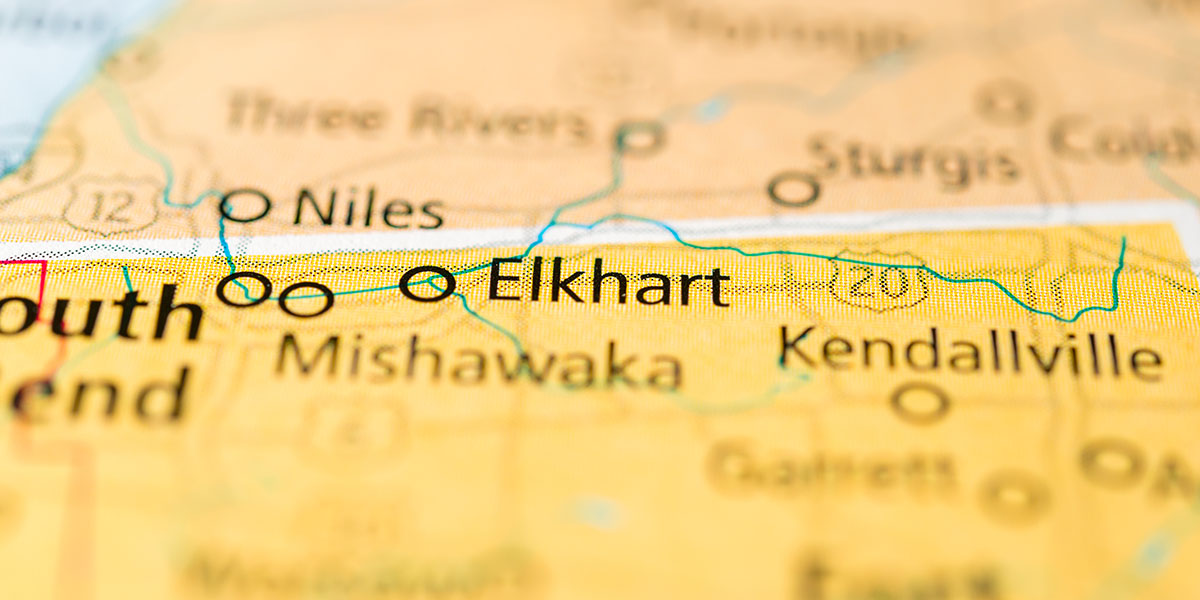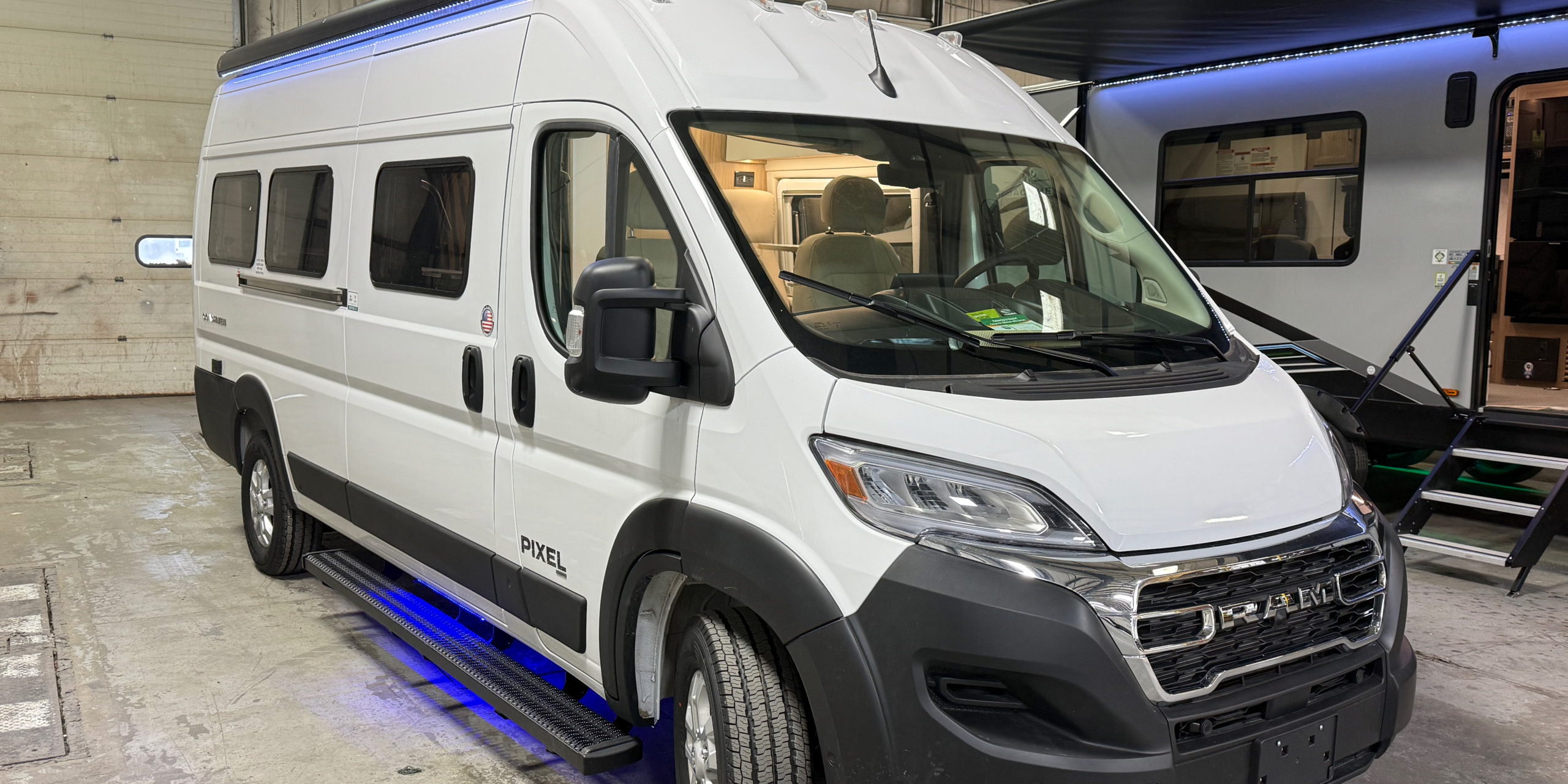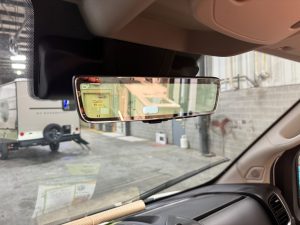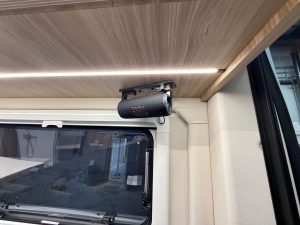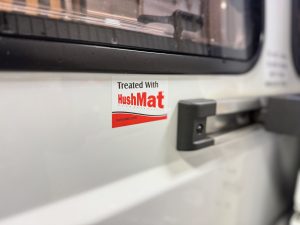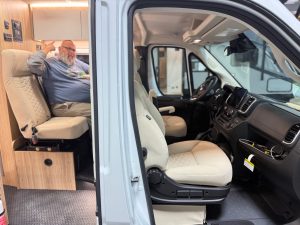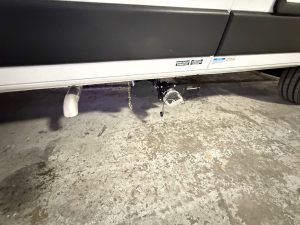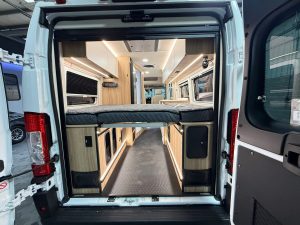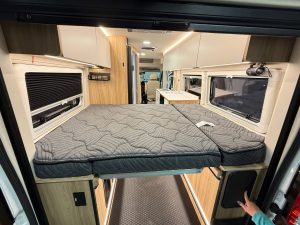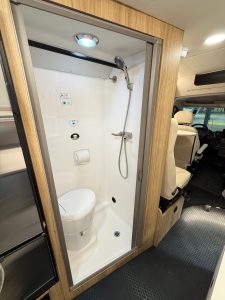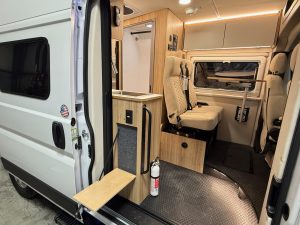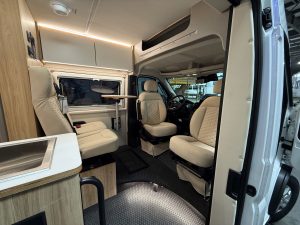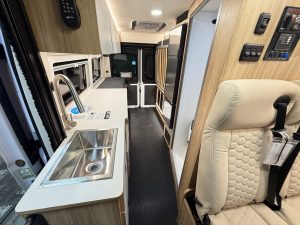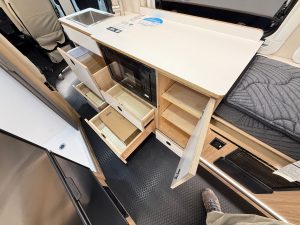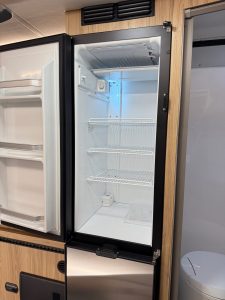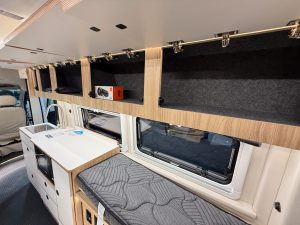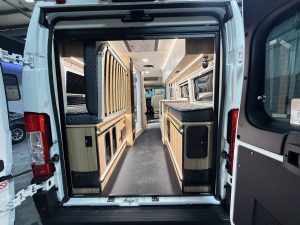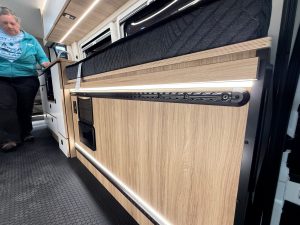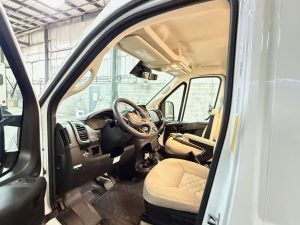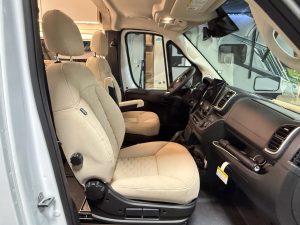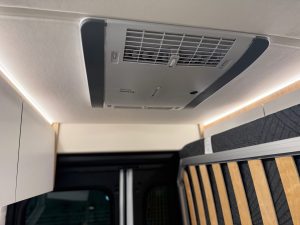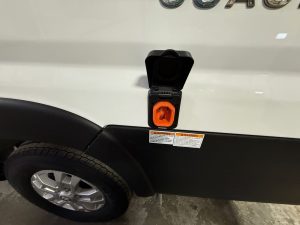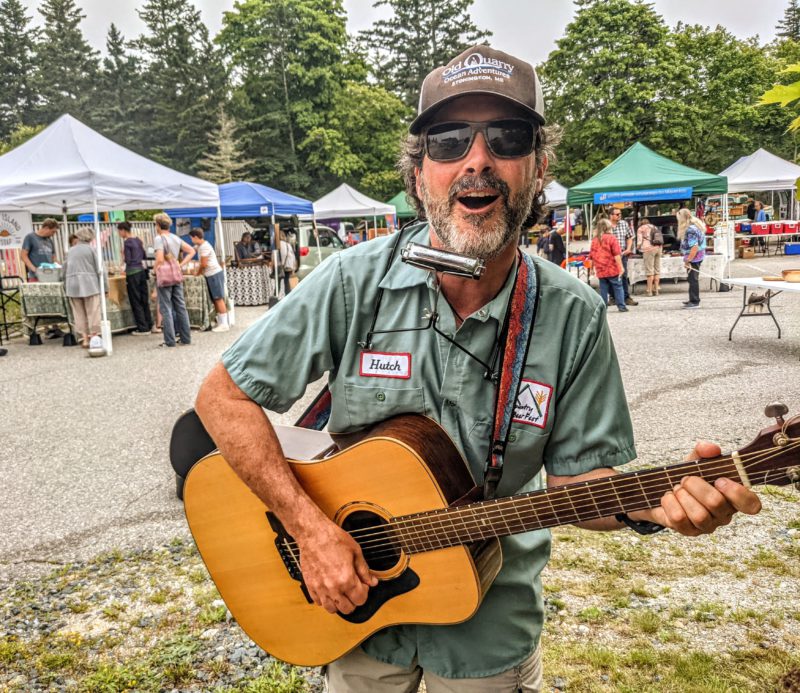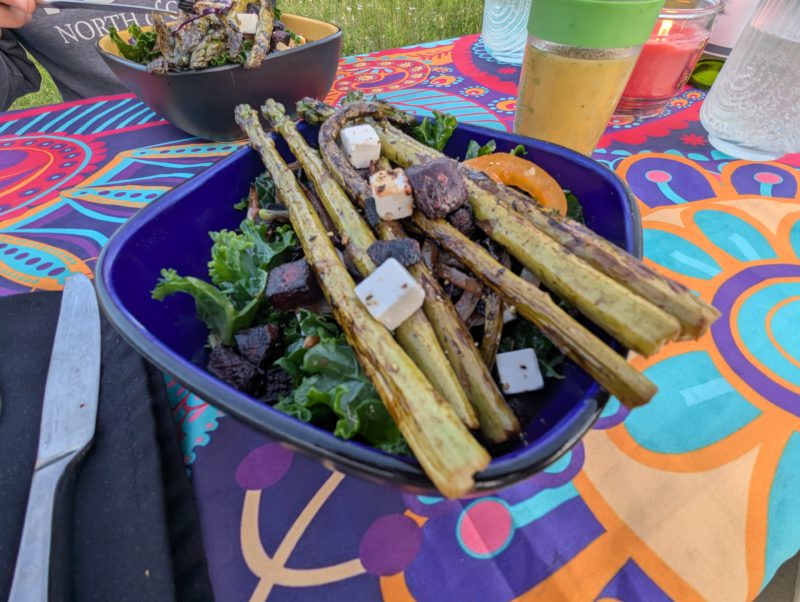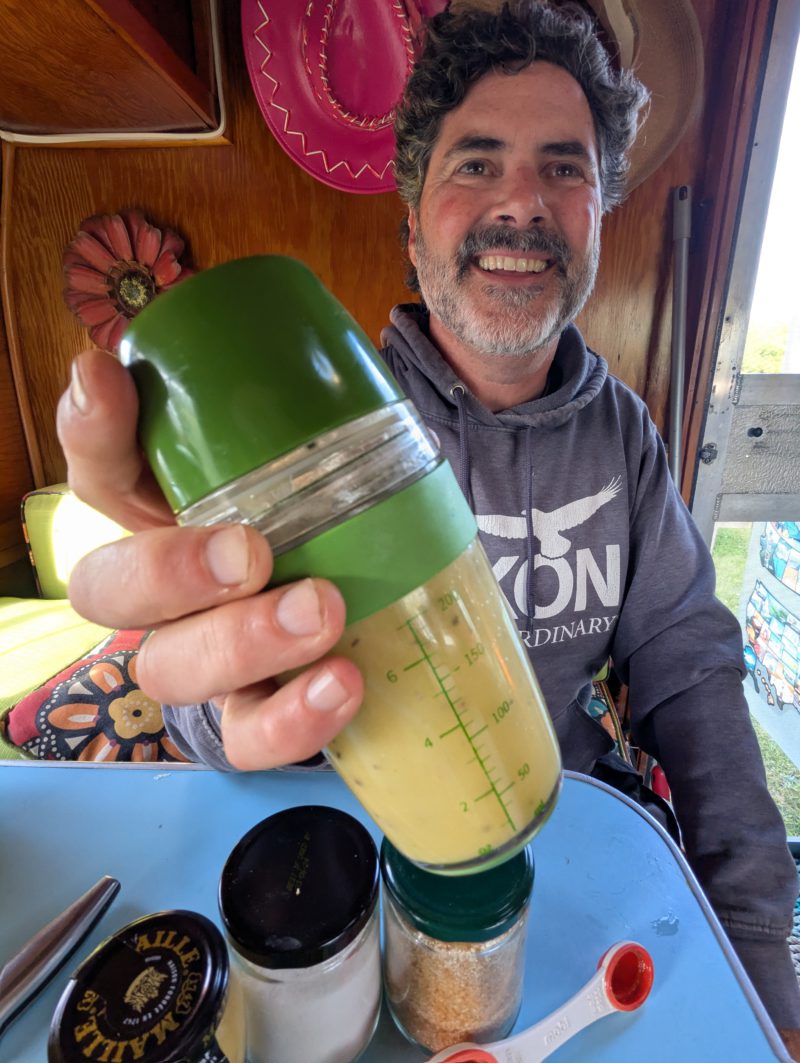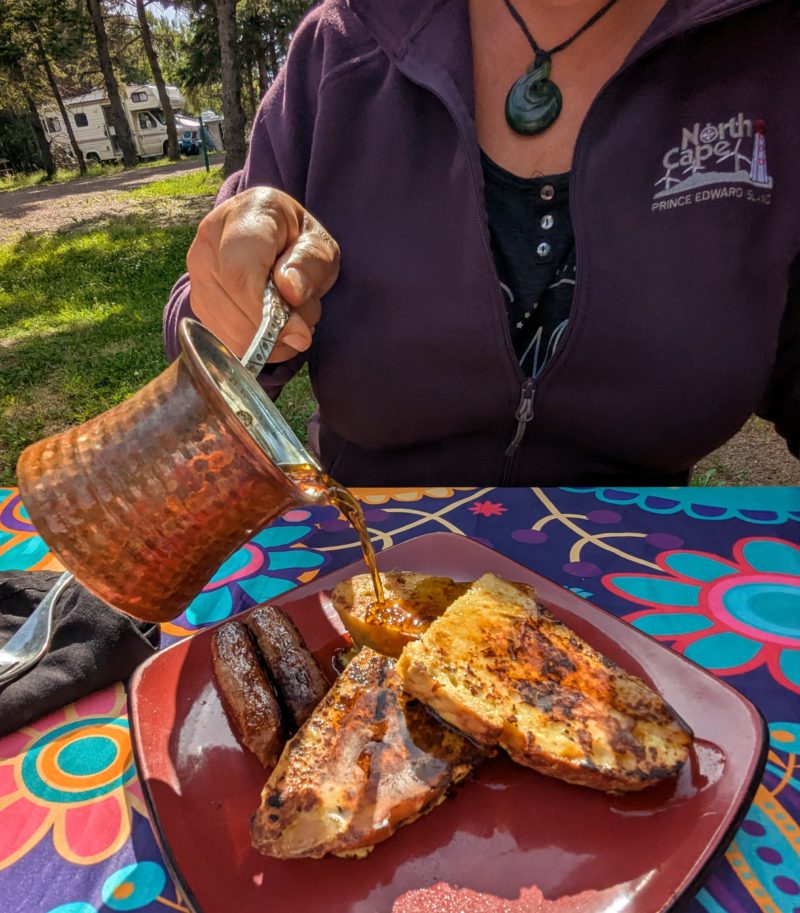Not surprisingly, the most obvious use case for the 2025 East to West Alta 2870KTH is as a toy hauler. But you might want to seriously consider another role this bumper pull trailer neatly fulfills — the remote workstation. It’s especially suitably for those with larger families or who those enjoy camping in more extreme weather conditions.
The Alta 2870KTH comes with a lot of standard features that are very useful, and the interior is definitely a step up from many other toy haulers. While there are a few challenges (we’ll talk about those), overall this toy hauler could be viable option for RVers whose interests go beyond toys and garage space.
At a Glance: Alta 2870KTH
I gave the 2025 East to West RV Alta 2870KTH a rating of 8.0 out of 10 stars, a high score. The combination of a flexible use case, very pleasant interior, off-grid and cold-camping capabilities, and its overall build quality were all definite plusses.
However, the small oven, low-grade ventilation fans. and lack of a tire pressure monitor system (plus entry-level suspension) are all items that should be considered. But, aside from the oven, all of those other features can easily be upgraded by an interested buyer.
[review_summary class=”custom-class” title=”2025 East to West RV Alta 2870KTH” description=”This score is awarded by an expert reviewer conducting an independent assessment of the RV.”]
Check the Specs
- Sleeping capacity: 6
- Hitch weight: 1,405 pounds
- UVW: 9,008 pounds
- CCC: 2,692 pounds
- Exterior length: 32 feet 11 inches
- Exterior height 12 feet 5 inches
- Exterior width: 8 feet 5 inches
- Fresh/Gray/Black: 106/60/30 gallons
- Propane: 2 x 20-pound tanks
- Awning: 19 feet and 8 feet (two awnings)
- MSRP: $84,596 (estimated)
Features We Love
- Off-grid chops: 160 gallons of fresh water, 400 watts of solar, provision for an on-board generator, and a built-in, 1,800-watt inverter
- Individually deployable power stabilizer jacks
- Bathroom with very high ceiling and retractable shower door
- Very nicely done interior lighting (dimmable ceiling ribbon lighting, lighting in the toe kick of the kitchen cabinet, under-counter lighting)
- Onboard fueling system
- Onboard air compressor
- Three-season patio doors plus patio deck
Benefits
On the Level, Inside and Out
- Excellent off-grid camping capabilities. The Alta 2870KTH comes loaded with solar power and lots of freshwater capacity.
- Power stabilizer jacks. Many power stabilizer jacks are deployed in pairs but, if the ground is not even, this can mean one side is bearing much of the weight while the other does little to stabilize the rig. This trailer features power stabilizer jacks where each jack has its own switch enabling them to be optimized for the condition. A minor detail that can make a big difference. This is the first time I’ve seen jacks configured this way.
- Extra headspace. The high ceiling height in toy haulers like this make them a great choice for taller travelers or even those who value the headroom, particularly in the shower.
Garage Gizmos
- Ability to fuel toys. The on-board fueling station with 30-gallon tank would enable someone to fill gasoline-powered vehicles like motorcycles, ATVs and the like so they could be transported with little or no fuel aboard and simply gassed-up at the destination.
- Inflatability. Having an on-board compressor can enable inflating things like water toys, mattresses, tires and more. This is a great feature in any RV but especially useful in a toy hauler where you may want to inflate/deflate tires on off-road vehicles based on conditions.
- Instant deck. The ramp door on this trailer features a surround that forms a fence of sorts plus a provision to set the door horizontally. So, you can use the ramp door as a patio deck. There is also a glass patio door with bug screens called a three-season door so you can go in and out. This makes a great place for entertaining, particularly if you’re camped somewhere with a great view. These are also good to contain pets or smaller children which allows them to go in and out but still staying within the confines of the camper.
Challenges
- Cost-cutting compromises in the kitchen. The kitchen in this RV is beautifully done with plenty of storage, but the smaller 17-inch oven and four-inch overhead vent fan really are cost-cutting compromises that take this space down several notches, especially for those who like to entertain.
- No TPMS. There are high-quality Goodyear Endurance tires but no internal tire pressure monitor system — a safety feature that I personally consider essential.
- Basic suspension. The simple leaf spring suspension allows more road shocks to be transmitted to the RV which could decrease damage and make towing less pleasant.
- Weight. The large holding tanks and hefty build to accommodate toys means this is a heavier trailer and the choice of a tow vehicle should be made conscious of these weights.
Best For
- Off-grid adventurers with toys. The obvious use of any toy hauler like the Alta 2870KTH is to haul toys. But some of this model’s additional feature make it particularly appealing. For those who like to camp off the grid, or boondock, the huge freshwater tank, 400 watts of solar, 1800-watt inverter and provisions to add an on-board generator might make this a top-of-list choice for those off-grid camping adventures.
- Remote workers. The large, open space and drop-down patio make an RV like this ideal for those camping in beautiful places with a patio deck to observe them. An RV with this flexible an open space is also a great choice for those who work on the road or have hobbies that might be made more enjoyable in a larger, open space.
- Taller travelers. The higher ceiling height makes a trailer like this a first-rate choice for taller travelers where showers, in particular, can be challenging in other RVs.
- Socialites. The opposing couches and flexible interior are also great choices for families or for those who like to entertain — or enjoy game nights or meal gatherings.
Key Areas We Evaluate for RV Buyers
Sleeping Space
At the front Alta 2870KTH is a king-size bed in a slide room. This bedroom space has a set of drawers and hanging storage along with a larger closet. So, there is also a lot of space for clothing. (Which makes sense if you’re bringing adventure-related gear in the cargo bay.)
Additionally, in the cargo bay, there is a bed-lift mechanism (HappiJac) with a second larger bed and opposing couches that can — you guessed it —create yet another bed. While these two sleeping spaces have thinner cushioning (owing to the fact that they can be lifted up against the ceiling), they still would work for both adults and children. The beds in the back are in the main living space, so they do provide less privacy than if they were in their own room. But an additional room is unrealistic in a toy hauler of this size.
Bathroom
The bathroom in the Alta 3870KTH is in the center of the floorplan. It offers an entry door both from the hallway and from the front bedroom. There is a step-in shower that uses a retractable shower enclosure, which I really like (as opposed to glass doors).
One of the reasons people like toy haulers is that the ceiling height is much greater than a traditional travel trailer. So, one benefit to the bathroom is that you find a very high ceiling here as well. (In general, this makes a toy hauler a really good choice for taller travelers.)
This model features a porcelain toilet (fancy); but the sink is smaller, and there is virtually no counter space in here. Also, another disadvantage is that there is a small 4-inch vent fan, which generally does little more than make noise. I prefer the higher-performance vent fans in the bathroom.
Living Area
The living area in the Alta 2870 is a combination of things — including the cargo bay, of course. The HappiJac bed features opposing couches. Additionally, there is a table that can be mounted on three press-in poles where you could accommodate up to six people. That makes this a good choice for those who like playing games or just sharing mealtimes.
There are also two reclining chairs that are freestanding. One of the nice things about this is that you can bring them out onto the patio deck. That deck is the ramp door that you use to roll-in toys, but there is a provision to have it vertical. Conveniently, there are screened gates around the perimeter. These patio decks are another real plus of toy haulers.
Further, this model features a power awning over the patio deck, which is typically an extra-charge item but is included standard in the Alta 2870KTH.
There is a glass sliding door between the main living space and the patio deck (they call this a “three-season door”), as well as screens that cover the space as well. In colder camping situations, the rear deck can just be folded up and closed. I’ve seen many RVers choose toy haulers for the patio feature along with the flexibility of being able to retract the opposing couches up against the ceiling with the power-lift mechanism.
Kitchen
There is a good amount of counter and storage space in this kitchen. Plenty of drawers and cabinets take full advantage of the higher ceiling height. The kitchen also features a multifunction sink with a veggie washer, strainer, and even cup-rinser. On top of everything else, there’s a high-rise commercial-style faucet.
East to West RV has done a good job with illumination in this trailer by using under-counter lighting, placing lighting in the toe kick under the sink, and adding dimmable beam lighting in the ceiling. This really shows in the kitchen space.
However, the company cut corners on the three-burner stove with its unfortunate 17-inch oven. These generally have hot spots and aren’t quite large enough for more than cookies or a pizza. It’s an unfortunate blemish on an otherwise really good kitchen area. Another bummer is the four-inch fan in the ceiling. (Which won’t do much to exhaust fumes at all.) There is also an outside kitchen in this trailer that features a flat-top griddle and a smaller bar-sized refrigerator.
Four-Season Capabilities
The Alta 2870KTH is very well-suited to camping in more challenging climates with a heated and enclosed underbelly. The walls in this trailer are one and one-half inches thick. That is thicker than typical and affords better insulation. Also, the roof of this trailer is a vacuum-laminated build incorporating foam insulation. This is also rather unusual and is a better way to do things.
Storage Space
The most obvious storage in this is the cargo bay of this toy hauler which measures 14 feet overall. This is also a wider-body trailer at 101 inches. These dimensions afford more storage in the cargo bay, but there is a slide room that reduces the width of part of the storage apse in the cargo bay. So, some larger vehicles like side-by-side off-road vehicles may not fit.
There’s a cargo door (like a baggage door) on the camp side of the trailer that accesses the cargo bay, which is a handy way of tossing in those last-minute pieces of the camping puzzle you may have.
The Alta 2870KTH also features a taller outside storage compartment at the front of the trailer. (This space would work for things like fishing poles or other longer/taller items.) When I was selling a similar floorplan in my former days at a dealership, we would jest that this would be the place an artist might store their easel. (And that’s not completely unrealistic.)
Chassis/Suspension
The suspension on this trailer is a simple leaf spring design, which tends to transmit more noise and vibration to the trailer itself. It can also accelerate wear compared to trailers with more sophisticated suspension systems. Many people I know who get trailers with these low-grade suspensions and do a lot of towing often upgrade them with better components to reduce vibration in the trailer.
The stabilizer jacks on this trailer are unusual in the fact that each of the four jacks has its own button. So, if you’re camping in a place where the surface is uneven, you can deploy the jacks based on the ground surface. I haven’t seen this before, but it’s a feature I really like.
Garage
While the total length of the garage in the Alta 2870KTH is almost 14 feet long, the kitchen slide in here does make it narrower the front end of the space. So, that may reduce the variety of toys you can bring into the space. Certainly, a number of side-by-sides wouldn’t fit, but things like motorcycles, e-bikes, or other such toys would comfortably fit.
In the garage, there is a power lift mechanism called a HappiJac system that lifts the upper berth to the ceiling when it’s time to load-up. As mentioned earlier, there are also opposing couches that also ride this chain-driven mechanism to go against the berth when it’s lifted.
While we each have what serves us well, I just am impatient watching these things slowly move their way up toward the ceiling. Again, it’s a very common system and one that allows the couches to also be a bed and allows six individuals to sit facing one another which makes game nights or meals more pleasant.
Value
While many RVs give you a lot of choices, ultimately, you really want all the features. And the Alta 2870KTH comes with them. The awning over the back patio, the back patio railing, the three-season glass patio doors, the individually-controllable power stabilizer jacks, and so many other features are just part of what’s included on this trailer.
Something else that is becoming less common is a ladder to the roof. Many RV companies are cutting costs by simply adding a ladder mount, and you have to buy the ladder yourself, yet all RVs require inspections of all the seals. Not with the Alta 2870KTH. The ladder is included.
I also like that there is an air compressor, included as well as a fueling station. In many lower-priced RVs the air compressor isn’t something they include at any price and the fueling station may be an option. Here, they’re both standard — great features for a toy hauler.
However, I have to downgrade the value somewhat due to the almost worthless 17-inch RV oven and small vent fan in the bathroom. These are such glaring examples of cost cutting that do affect the usability of an RV over time.
Closing Notes on the Alta 2870KTH
Thoughts on Build Quality
There are a number of ways the Alta 2870KTH is built differently which could be argued as better than what is more commonly found in the industry. One of those is how the walls are built, which are two inches thick and use a product called Azdel as a substrate. The walls in RVs like this are made up of various layers including an outer layer of fiberglass and an inside wall board. Between those layers are welded aluminum studs with block foam inserts.
It has traditionally been a wood product used just inside the walls (called lauan), but this material can get damaged if even the smallest amount of water leaks in. This model uses Azdel which is unaffected by water. Further, Azdel offers better sound insulation properties.
The roof on this trailer, too, is a laminated build using welded aluminum trussing with block foam as well. Laminated roof structures are unusual, but I really like them.
I’m also a fan of the Lippert thin-rail slide mechanism that this trailer uses.
A Toy Hauler with Broad Appeal
With the Alta 2870KTH being a toy hauler, that fact might take this off some buyers’ lists — but it shouldn’t. East to West RV has done a very good job making the interior of this trailer feel pleasant, and there are a lot of nice touches like the upgraded sink and nice storage in the bedroom. I also like how many of the features that comparable models in this category count as options are included here — things like the larger solar array, the awning over the patio, the gate around the patio, the three-season patio doors, and more.
Another use case for a toy hauler with a patio deck is for those with small children or pets. Those smaller campers can take advantage of a lot of floor space, including the patio deck. (You know, without worrying about them wandering around the campground.) It’s also a way to go inside and out, but still have the fence around the deck. (Which should reduce the chance of escapes into the wild.)
Overall, I think this trailer could serve a variety of RVers very well and accommodate a number of varying use cases with the flexible interior and included features.
A Note on the RV Trader Review Process
RV Trader asked RV shoppers what was most important to them in their RV buying process. Potential buyers — like you — helped us to identify a list of six key areas that camping and travel enthusiasts always look at when they’re searching for the perfect RV: sleeping space, bathroom, living area, four-season capabilities, and storage space.
The RV Trader team then got to work providing you with honest and unbiased evaluations. If you’re wondering, that’s where I came in. As an RV expert and enthusiast, I provide an honest look at RVs from an RV industry insider perspective.
Make Your Move
Start shopping for the year, make, and model. Find Your Alta
What Other Campers Are Saying
Read the best reviews by owners. Search for an RV Model
